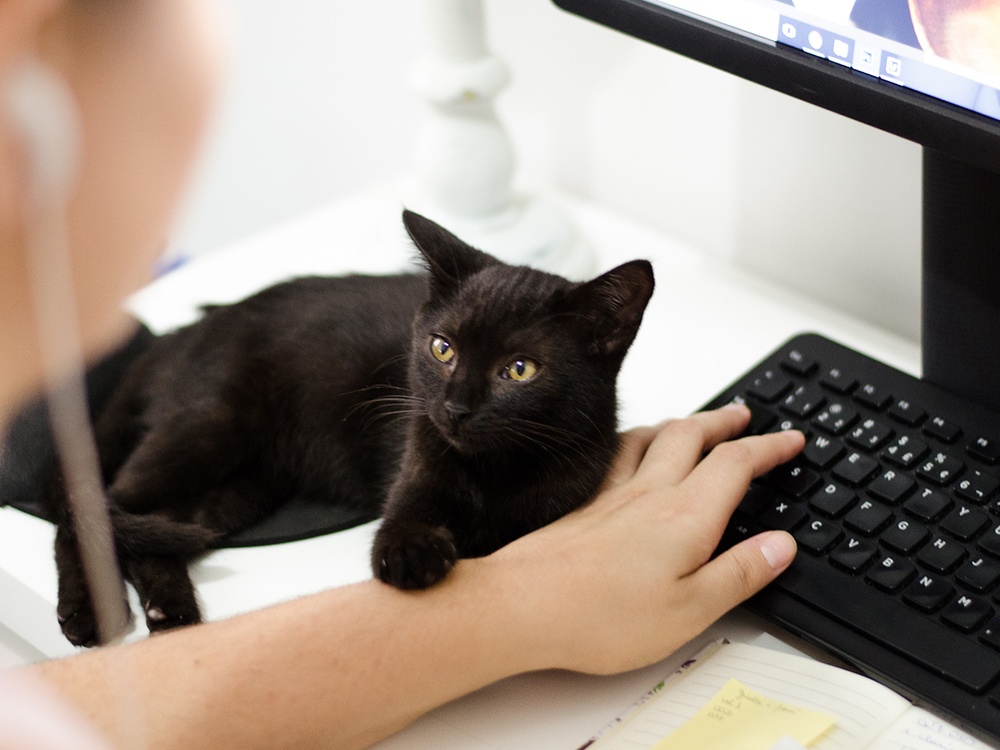Online Veterinarian Guide: Everything You Need To Know About Online Pet Vets
When a pet health issue arises outside of your primary vet’s office hours, or you need advice from a professional but not necessarily an appointment, an online pet vet is a reasonable option.
Virtual veterinarian appointments are a newer healthcare option for pet parents that are quickly gaining popularity. Online vet appointments are more convenient and easier to access than in-person office visits. With a virtual vet visit, you and your pet may not even need to leave home if a physical exam or treatment isn’t required.
Online veterinarians can help pet parents decide how urgent their pet’s health concerns are, offer general medical advice, and answer pet health and product questions.
Online Pet Veterinarians: Are Online Vets Real Veterinarians?
Yes. Reputable online pet vet service providers work only with licensed veterinarians or vet techs. Rather than sifting through message boards for sound advice or losing hours to a google search panic spiral, you can get fast and accurate medical advice for your pet.
How Do Online Pet Vet Services Work?
Pet telehealth options are an easy and accessible way for pet parents to connect with trained professionals. Virtual vet appointments include text or message services and video consultations.
With online pet vet services, you talk to a veterinarian or vet tech over text, phone, or video through a service like Pawp or Vetster. Similar to an in-office visit, you talk with the professional about your concerns and receive advice on the next steps.
While a virtual pet visit is not always a replacement for a traditional in-person vet appointment, online vet appointments are a helpful alternative for many situations.
What Can You Use an Online Vet Service For?
Online veterinarians are an ideal resource for many pet health situations. They can help with non-emergency concerns, and general health questions, and can even help you decide if your pet needs a trip to the emergency veterinary hospital. These services can offer specific advice on how to prepare for the pet emergency room if your pet needs it.
General Pet Health Questions
An online pet vet can help pet owners navigate non-emergency pet health situations like a suddenly limping cat or a dog that keeps shaking its head or licking itself.
Advice On Pet Care
Online veterinarians commonly help pet parents with questions on preventative care, like choosing topical flea medication for a new cat or application tips for heartworm preventative medication for their dog.
Online vets can also help with tips and tricks on administering medication to your pet when you’re struggling to get your cat to swallow a pill or offering advice when your dog keeps somehow pulling the bandage off their paw.
Deciding When A Concern Is An Emergency
Known as Teletriage, online veterinarians can help decide if your pet needs emergency care or can wait for an appointment.
For example, your dog has been vomiting all day, but it’s a holiday weekend. An online vet visit can help review your dog’s history and clinical signs. This process can help differentiate between various causes of vomiting and whether an urgent evaluation by a veterinarian is recommended.
For example, a puppy who is unvaccinated and is vomiting may be at risk for parvovirus. An in person evaluation by a veterinarian is the best choice for this situation.
While an otherwise healthy adult dog who ate a piece of bacon this morning and has only vomited once is a good situation for an online veterinary appointment. They will likely be recommended with a bland diet and monitoring.
Off-Hours Follow-Up Concerns
Follow-up questions are a normal part of the healing process for pets treated for an illness or recovering from a procedure. Following up with your primary veterinarian is the best option. However, when a concern arises outside of normal office hours, an online vet consultation can be a great resource.
Online vets can review photos of a surgical incision that looks a little off or discuss a minor side effect of a new medication. When your primary care veterinarian is back in the office you can follow up in person to give your pet the best care.
The Limitations of Online Veterinary Care
Virtual pet appointments are a great resource for pet parents and pets experiencing health concerns. However, many pet health issues require in-person care. Some conditions that call for immediate or even emergency veterinary care include:
More Than One Day of Not Eating Plus Vomiting or Diarrhea
Persistent Vomiting or Diarrhea
Difficulty Breathing
Trauma - All trauma requires urgent veterinary care
Open Wounds That Won’t Stop Bleeding
Collapse, Weakness, or Becoming Non-Responsive
Conditions Such As Seizures or Paralysis
Toxins - Poisoning of any sort is an emergency; you can also call ASPCA Poison Control (888-426-4435) or the Pet Poison Helpline (855-764-7661).
Inability To Urinate
Sudden Vision Issues or Ocular Trauma
Anaphylaxis or Anaphylactic Shock
Pregnancy or Birth Complications
When Should I Bring My Pet To The Emergency Vet?
How Much Does a Virtual Vet Visit Cost?
Connecting with a veterinary professional via chat or video is easier than ever thanks to the variety of online vet help available.
Some online vet appointments are paid per appointment or on-demand, like Vetster. Prices vary by location and specific veterinarians, but you can expect to pay between $30 and $60 for a visit.
Some are subscription-based, like Pawp, which has an annual fee for anytime access.
While others are a feature of another membership plan. Like Chewy’s Connect With a Vet, which is free for Autoship customers, or PetCoach, which is free for pet health insurance policyholders of Petco.
Depending on your chosen type of service, you can talk to professionals through video calls, live chat options, and standard phone calls.
Are Virtual Vet Visits Cheaper?
Virtual veterinarian costs vary (just like traditional vet consultations), but they are typically less expensive than in-person vet visits. An online vet visit is a resourceful choice for pet parents on a tight budget although they do come with limitations.
Are There Free Online Vet Options?
Technically, no. However, many online pet veterinarian services offer limited trials for free that allow you to chat with a vet online. For example, Pawp offers a 7-day free trial.
Can Online Vets Write Prescriptions?
Online veterinarians can’t legally write prescriptions in most states. Many states require that a veterinary-client-patient relationship is established before writing prescriptions. This often includes a requirement that the pet is examined in person.
Telepaws offers a map of which US states allow online prescriptions.
If your state forbids online prescriptions, you can still have an online vet appointment for your pet. If your pet is determined to need medication, you can follow up with an in-person appointment with your primary veterinarian. Or in a critical situation, an emergency pet hospital to get your pet the medication they need.
What Can An Online Veterinarian Do?
Online veterinary visits range from chat-only options to virtual video appointments. In chat-based care, pet parents can ask more simple questions and receive a direct answer.
Chat options are a good choice for pet parents with simple questions or those without video chat options. Many chat messaging services include options to share photos, allowing the vet to give more relevant advice.
Televet video appointments are closer to traditional veterinary appointments. The veterinarian can see your pet via video and can discuss your concerns in more detail.
With both options, the veterinary professional may be able to share relevant articles, holistic care advice, product recommendations, or help find a veterinary clinic nearby.
How To Prepare For Virtual Pet Vet Appointment
The better prepared you are for your virtual vet appointment, the better. Being prepared for your veterinary telemedicine appointment gives the virtual vet team the ability to give your pet the best care. To prepare for your online vet visit have the following info handy:
A list of your concerns and any specific questions you have
List your pet's symptoms and a timeline of when they began
Relevant pictures or videos of your pet’s symptoms
Your pet’s medical history, including all past surgeries and illnesses
A list of medications and supplements your pet takes including dosing information
List any allergies your pet has
List food and treats your pet eats - especially if anything has changed recently
Before starting the online vet visit:
Have your pet with you if possible for video appointments so that the veterinary care team can do a virtual exam if needed.
If you are able, have an additional person with you to help with positioning your pet for a virtual exam or holding the camera for you to show details of your pet’s condition.
Choose a quiet and calm environment to make your call.
Double-check your internet connection and the battery life of your phone or other device before calling to prevent a dropped appointment.
Take a few moments to collect your thoughts and check your notes before making the call. Being calm and clear at the appointment will help your pet get the best care.
What to Expect In An Online Veterinary Appointment
The online veterinarian will connect with you via app or your provider software and will review the basics of your pet’s info.
Similar to your typical veterinarian appointment, they will ask you to describe your concerns about your pet. You will review relevant medical history and medications and they may want to see your pet’s symptoms through photos, videos, or video chat.
To get the most from the telehealth consultation, be ready to answer more questions in more detail than you’re used to. Virtual veterinarians aren’t able to do a hands-on exam of your pet and will rely on you to give accurate and detailed information to give your pet the best care.
The veterinary professional will then narrow their diagnostic assessment with more detailed questions and offer their diagnosis and treatment options. You may be directed to immediately go to an emergency pet hospital, follow up with your primary veterinarian, or receive at-home holistic treatment advice.
Online Pet Vets: A Useful Resource
Using an online pet vet service is a great option for giving your pet the best healthcare. From general questions and concerns to health advice and even second opinions, virtual vet visits allow pet parents to communicate with online veterinarians anytime and anywhere.
Online pet vets offer options for better care for your pets and relief for pet parents' concerns for their beloved pets.
Fact checked by Veterinarian

Dr. Paula Simons is an Emergency and Critical Care veterinary resident on her way to becoming a veterinary criticalist. She is originally from Philadelphia, Pennsylvania, and completed her veterinary training in Ontario, Canada, at Ontario Veterinary College. Dr. Paula Simons has a particular interest in critical care nutrition, trauma, and pain management. She enjoys the management of surgical patients and troubleshooting complex cases. Additionally, she is a huge advocate for her patients and ensuring their comfort. She has two cats named Moo and Kal, whom she loves dearly. More About Us












